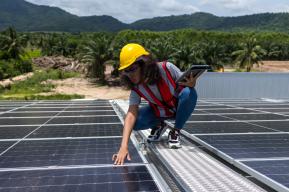Article
Project “Hamburg Climate Scale”
Project partners: Hamburg Climate Protection Foundation

Objectives
The Hamburg Climate Scale Project: Playfully promoting climate awareness
Climate and resource protection are globally significant matters that also influence the daily lives and consumption patterns of individuals at the local level. It is estimated that every German citizen generates approximately 9-12 tons of CO2 emissions annually. To address concerns of climate justice and resource preservation, reducing emissions to less than 3 tons per person per year is deemed necessary.
In response to these challenges, Hamburg has devised an innovative educational tool known as the "Hamburg Climate Scale." This project aims to empower individuals to understand and mitigate their carbon footprint while fostering climate-friendly behaviours by illustrating practical ways for consumers to reduce CO2 emissions in their everyday activities and adopt climate-friendly alternatives.
The climate scale is a simple mechanical kitchen tool equipped to accommodate specially designed models. These models represent various products and behaviours, enabling users to visually compare climate-damaging and climate-friendly choices. Through hands-on activities, participants learn to estimate CO2 emissions, assess their carbon footprint, and explore alternative consumption decisions. The scale serves as a catalyst for discussions on climate and environmental issues across different facets of life.
Objectives and Target Group
The primary objective of the Hamburg Climate Scale project is to raise awareness about climate change and its local implications. By providing a tangible and interactive tool, the project seeks to engage citizens of all ages in discussions about climate impacts and sustainable alternatives. The Hamburg Climate Scale facilitates a comprehensive exploration of climate impacts across various domains, including nutrition, transportation, consumption patterns, textiles, energy usage, and waste management. Locals learn to estimate the CO2 emissions linked to different products and behaviours, enabling them to contrast climate-friendly and climate-damaging choices.
The scale also stimulates discussions on climate and environmental issues, fostering awareness across different aspects of life and consumption habits. Additionally, it allows locals to roughly calculate their carbon footprint on a weekly, yearly, or other basis, encouraging reflection on personal consumption decisions and the exploration of alternative options.
The target group includes schools, environmental education institutions, universities, companies, and community events where climate-related topics can be explored in a playful manner.
Implementation
Modalities of Learning Opportunities
The Hamburg Climate Scale serves as an educational resource on climate change and is available for borrowing from BUKEA without any charge. Similar models of the scale can be found in various cities, including Hamburg, Saint Petersburg, and Petrozavodsk in Russia. Delivered in a convenient wooden box that easily fits in a car, those interested can contact BUKEA to inquire about its availability for their desired date. It is the borrower's responsibility to pick up and return the scale, ensuring its completeness and condition are maintained. A manual containing essential information accompanies the scale. More detailed information and contact addresses can be accessed on the internet. For presentations, only a table is necessary, along with the option of a board or screen for any written content.
Partnerships and Coordination
Multiple stakeholders collaborate to ensure the success of the Hamburg Climate Scale project. Key partners include the Ministry for the Environment, Climate, Energy and Agriculture (BUKEA), which oversees the development and financing of the project, and the Hamburg Climate Protection Foundation.
Funding and Costs
The project's main sources of funding stem from government initiatives and environmental organizations committed to climate action. Borrowing the climate scale is free for target groups, with fees only applicable in cases of missing or damaged components.
Challenges
Despite the project's accessibility, challenges persist in creating custom climate scales tailored to local conditions and ensuring adequate training for moderators and educators. While BUKEA provides essential data and information, professional model makers are needed to craft visually appealing models suited to specific contexts.
Additionally, ongoing advertising efforts are essential to sustain interest and demand for the project. Also, there is no central coordination on climate protection either within the administration or between the many educational stakeholders.
Outcomes
Despite these challenges, the Hamburg Climate Scale project has yielded significant outcomes. Its engaging and interactive approach has spurred discussions on climate protection and personal behaviour change. Moreover, the project's expansion to other cities underscores its efficacy and potential for broader adoption. While the lack of exchange between different climate scales remains a concern, the project continues to enlighten individuals about the extent of their CO2 emissions and inspire meaningful action towards a sustainable future.





